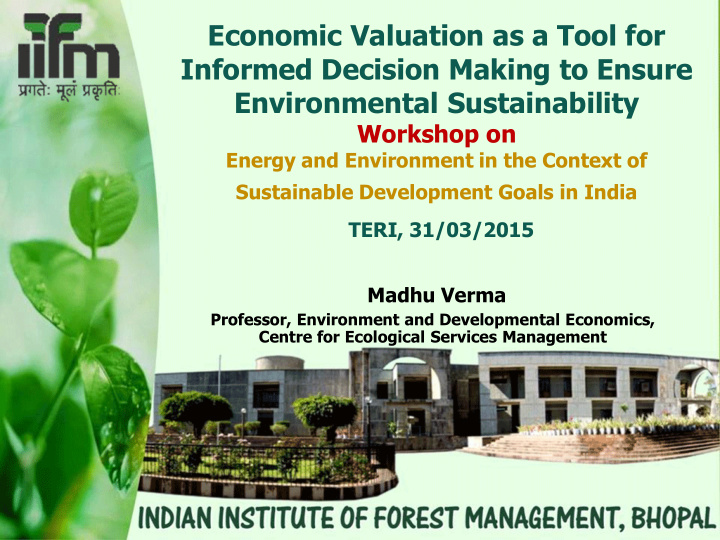



Economic Valuation as a Tool for Informed Decision Making to Ensure Environmental Sustainability Workshop on Energy and Environment in the Context of Sustainable Development Goals in India TERI, 31/03/2015 Madhu Verma Professor, Environment and Developmental Economics, Centre for Ecological Services Management
Centre for Ecological Services Management, IIFM Mission Conduct action and policy research for ecosystem services management Goal Function as a think tank to generate useful database and an appreciation for ecosystem services, their physical assessment, valuation and establish incentive based mechanisms to promote conservation.
Highlights and learning from few studies conducted at CESM
I. Economic Valuation of Tiger Reserves in India: A VALUE+ approach (NTCA) : A Case of Policy and Institutional Success Tigers vital for regulating and perpetuating ecological processes TRs also provide a range of ecosystem services A VALUE+ Approach 6 TRs across tiger landscapes: Corbett, Kanha, Kaziranga, Periyar, Ranthambore, Sundarbans Qualitative and quantitative assessment of 25 ecosystem services
Economic Valuation of Tiger Reserves in India: A VALUE+ approach Flow benefits: Rs. 8-18 billion/yr (0.5-2 lakh/ha/yr) Conservation of stock: Rs. 22 – 650 billion A large majority of benefits are intangible Large benefits at national and global scale Investment multiplier: 200 to 530 Mapping of 3 ecosystem services at 2 tiger reserves - Kanha and Periyar: a pilot Cost of Re-creating a TR (Rs. 500 billion)
Economic Valuation of Tiger Reserves in India: A VALUE+ approach Enhanced investment is economically rational Option values likely to be immense Economic values of TRs not comparable Benefit-sharing mechanisms required Connectivity and exchange of gene-flow critical Institutionalizing data collection Upscale the study to India and tiger-range countries
Complex linkages (Ecosystem Services Converted into Energy Factors)
II. Regional research to inform the High Level Panel on global assessment of resources for implementing the strategic plan for biodiversity 2011-2020: report for South Asia region (CBD) : Policy, Institutions and Market Strengthening Substantial quantity of evidence on the benefits of conservation and sustainable use of biodiversity in South Asia Benefits of biodiversity conservation are shown to be substantial and higher than the costs of conservation in most cases Net benefits are often locally negative but nationally or globally positive Little quantitative evidence on the investment needs, resource requirements and cost- effectiveness of options to meet the Aichi Targets Substantial gap between available and required resources for achieving the Aichi Targets
III. High Conservation Value Forests: an instrument for effective forest fiscal federalism in India (14 th Finance Commission of India) : Incentive Based Mechanisms Forests and externalities Inadequate motivation for states to keep areas under forests Suggested allocation based on High Conservation Value Index 14FC has included forest cover in the devolution formula (weight: 7.5) Case of conservation finance
IV. Revision of rates of NPV applicable for different class/category of forests (MoEFCC) : CLEV Detailed matrix for NPV rates (14 X 4) About 50% of the total economic value of forests is accrued at the local level Add-on factors of hill talukas and forested wetlands 10X for National Parks and 5X for WLS Possession Value of Land Afforestation to forest rehabilitation Discounting benefits from CA CAMPA monies to be shared with all concerned stakeholders NPV Hub for MoEFCC is under progress at CESM
Current and Proposed rates of NPV
V. Guidelines of cost-benefit analysis for forest diversion (MoEFCC) : Institutional strengthening Social costs and private benefits Detailed and extensive set of screening criteria Sector-specific guidelines for all major sectors CBA for different scenarios Results to be conveyed in clear and transparent manner Templates
Benefits Lost and Costs Imposed on account of Developmental activities
VI. Intergovernmental Platform on Biodiversity and Ecosystem Services (IPBES) (UNEP) ongoing work : diverse conceptualization and assessment of the multiple values of nature and its benefits, including biodiversity and ecosystem services : Multipronged approach Science Policy Interface Assessment of existing knowledge Engagement of a great diversity of stakeholders Explicitly embraces different disciplines and knowledge systems Push the frontiers of biodiversity science Also includes capacity-building, catalysing generation of new critical knowledge, and development of policy tools
Thank You
Recommend
More recommend